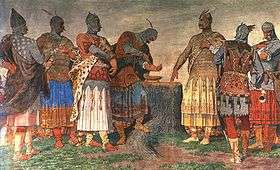Magyar tribes
The Magyar tribes or Hungarian clans (Hungarian: magyar törzsek) were the fundamental political units within whose framework the Hungarians (Magyars) lived, until these clans from the region of Ural Mountains[1] invaded the Carpathian Basin and established the Principality of Hungary.[2][3]
.jpg)
Etymology
The ethnonym of the Hungarian tribal alliance is uncertain. According to one view, following Anonymus's description, the federation was called "Hetumoger" (Seven Magyars) ("VII principales persone qui Hetumoger dicuntur", "seven princely persons who are called Seven Magyars"[4]), though the word "Magyar" possibly comes from the name of the most prominent Hungarian tribe, called Megyer. The tribal name "Megyer" became "Magyar" referring to the Hungarian people as a whole.[5][6][7] Written sources called Magyars "Hungarians" before the conquest of the Carpathian Basin when they still lived on the Steppes of Eastern Europe (in 837 "Ungri" mentioned by Georgius Monachus, in 862 "Ungri" by Annales Bertiniani, in 881 "Ungari" by the Annales ex Annalibus Iuvavensibus). The English term "Hungarian" is a derivative of the Latin "Ungri" or "Ungari" forms.
History
According to András Róna-Tas the locality in which the Hungarians, the Manicha-Er group, emerged was between the Volga river and the Ural Mountains.[1] Between the 8th and 5th centuries BC, the Magyars embarked upon their independent existence and the early period of the proto-Hungarian language began.[1]
Around 830 AD,[8][9] when Álmos was about 10 years old, the seven related tribes (Jenő, Kér, Keszi, Kürt-Gyarmat, Megyer, Nyék and Tarján)[10] formed a confederation[8] in Etelköz,[9] called "Hétmagyar" ("Seven Magyars"). Their leaders, the Seven chieftains of the Magyars, besides Álmos, included Előd, Ond, Kond, Tas, Huba and Töhötöm, who took a blood oath, swearing eternal loyalty to Álmos.[11] Presumably, the Magyar tribes consisted of 108 clans.[12]
The confederation of the tribes was probably led by two high princes: the kende (their spiritual ruler) and the gyula (their military leader). The high princes were either elected by the leaders of the tribes or appointed by the Khagan of the Khazars who had been exerting influence over the Magyars. Around 862 AD the seven tribes separated from the Khazars.
Before 881 AD three Turkic tribes rebelled against the rule of the Khagan of the Khazars, but they were suppressed. After their defeat they left the Khazar Empire and voluntarily joined the Hétmagyar confederation. The three tribes were organised into one tribe, called Kabar, and later they played the roles of vanguard and rear guard during the joint military actions of the confederation. The joining of the three tribes to the previous seven created the On-ogur (Ten Arrows),[10] one of the possible origins for the name Hungarian.
Social organization
The Hungarian social structure was of Turkic origin.[13]
See also
Sources
- Korai Magyar Történeti Lexikon (9-14. század), főszerkesztő: Kristó, Gyula, szerkesztők: Engel, Pál és Makk, Ferenc (Akadémiai Kiadó, Budapest, 1994)
- Kristó, Gyula: A Kárpát-medence és a magyarság régmúltja (1301-ig) (Szegedi Középkortörténeti Könyvtár, Szeged, 1993)
- Magyarország Történeti Kronológiája I. – A kezdetektől 1526-ig, főszerkesztő: Benda Kálmán (Akadémiai Kiadó, Budapest, 1981)
- Makkai, László (2001). Transylvania in the medieval Hungarian kingdom (896-1526), In: Béla Köpeczi, HISTORY OF TRANSYLVANIA Volume I. From the Beginnings to 1606, Columbia University Press, New York, 2001, ISBN 0880334797
References
- András Róna-Tas, Hungarians and Europe in the early Middle Ages: an introduction to early Hungarian history, Central European University Press, 1999, p. 319
- George H. Hodos, The East-Central European region: an historical outline, Greenwood Publishing Group, 1999, p. 19
- S. Wise Bauer, The history of the medieval world: from the conversion of Constantine to the First Crusade, W. W. Norton & Company, 2010, p. 586
- Gyula Decsy, A. J. Bodrogligeti, Ural-Altaische Jahrbücher, Volume 63, Otto Harrassowitz, 1991, p. 99
- György Balázs, Károly Szelényi, The Magyars: the birth of a European nation, Corvina, 1989, p. 8
- Alan W. Ertl, Toward an Understanding of Europe: A Political Economic Précis of Continental Integration, Universal-Publishers, 2008, p. 358
- Z. J. Kosztolnyik, Hungary under the early Árpáds: 890s to 1063, Eastern European Monographs, 2002, p. 3
- Carl Waldman, Catherine Mason, Encyclopedia of European peoples, Volume 1, Infobase Publishing, 2006, p. 508
- Paul Lendvai, The Hungarians: a thousand years of victory in defeat, C. Hurst & Co. Publishers, 2003, p. 15-29, p. 533
- Kevin Alan Brook, The Jews of Khazaria, Rowman & Littlefield, 2009, pp. 163-164.
- http://www.kislexikon.hu/hetmagyar.html (Hungarian)
- John P. C. Matthews, Explosion: the Hungarian Revolution of 1956, Hippocrene Books, 2007, p. 69
- Makkai 2001, pp. 415-416.
